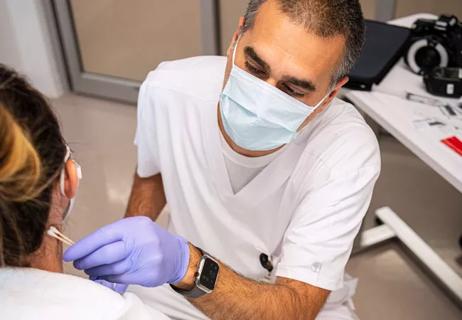Past traumas can affect a patient’s entire life

Healthcare providers who incorporate trauma-informed care techniques into their practice can open the door to healing for patients who have experienced some of life’s most difficult events and conditions.
Cleveland Clinic is a non-profit academic medical center. Advertising on our site helps support our mission. We do not endorse non-Cleveland Clinic products or services. Policy
In the final article in Consult QD’s three-part series based on the SHIELD healthcare safety conference in January, trauma experts Ashley Withrow, MSSA, LISW-S, and Michele Reali-Sorrell, DNP, RN, SANE-A, SANE-P, explain how past traumas may influence current health and behavior. The conference was moderated by Stephen Meldon, MD, Senior Vice Chair, Emergency Services, and Co-Chair of Cleveland Clinic’s Workplace Violence Prevention Committee.
Withrow, Program Manager for the Cleveland Clinic Police Department Victim Assistance Program, explained that trauma-informed care considers the patient’s entire life course to understand how their experiences contribute to the patient they are today. This includes events from childhood and adulthood.
It’s important to understand the cumulative experiences that affect the patient, Withrow said. She noted that plenty of evidence-based research links trauma with long-term negative health outcomes, including affects on brain development and cognition.
Withrow shared results of a study on adverse childhood experiences (the largest to date for children who have been exposed to trauma). The research considered experiences such as violence, abuse and neglect; having a family member attempt or die by suicide; having a family member suffer from mental illness; and instability in the home and/or community, such as poor housing quality, poverty, community disruption and lack of opportunity. The results showed a direct correlation between trauma and an increased risk in disease and disability.
“More than 60 percent of adults surveyed had at least one of these experiences,” Withrow said. “Nearly one in six experienced four or more, and the more experiences one encounters, the greater risk they face for challenges later in life.”
Those challenges can include:
“Experiences of trauma can be very real for patients on a daily basis,” Withrow explained. “Patients may have triggers related to the trauma that affect them, and there are things healthcare providers do that can make those triggers worse.”
Seemingly small changes in communication techniques can go a long way. For example, Withrow cautioned clinicians to ask patients “What has happened to you?” rather than “What is wrong with you?”
Reali-Sorrell, nurse manager for Cleveland Clinic’s Forensic/SANE nursing program, agreed and said recognizing trauma symptoms in patients is key. “If a patient discloses that they are experiencing sleep problems, flashbacks or bad dreams, or that they are avoiding places or people or are having a hard time remembering things, these should all be noted,” she commented.
Other trauma symptoms may include:
When caring for a patient with trauma symptoms, Reali-Sorrell offered several recommendations – all of which were based on six guiding principles of trauma-informed care:
“You want to create an environment of safety for that patient and take the time to explain to them what is going on,” Reali-Sorrell said. “Be present and focus intently on the patient and their needs to make them feel they are important to you.”
Similarly, Reali-Sorrell explained that sometimes patients have a disproportionate relationship with their provider and feel that the provider has power over them. To help promote equality in the relationship, providers can ask patients what their priority is and what they need.
She also stressed the benefit of offering patients community or internal resources, such as educational reading materials or connection to a social worker. “Collaboration with other caregiver disciplines will ensure continuity of care and help avoid repeat cases,” she added.
Within Cleveland Clinic’s forensic nursing program, Reali-Sorrell and her team work hard to put the guiding principles of trauma-informed care into their practice. Clinicians are trained through the forensic nursing program. They see patients for hour-long visits that include multiple disciplines. Patients are offered support such as transportation to and from appointments or to repeat tests or lab work. Patients also can call in for virtual appointments to avoid multiple hospital visits and to center the experience on their own needs.
Withrow and Sorrell expressed the importance of empathy when caring for victims of trauma and helping patients heal from their experiences.
Providers should keep in mind that they don’t know whether the patient is sharing their trauma for the first or the hundredth time, Withrow said. “In many cases, victims feel as though they won’t be believed or supported, so we need to shape that survivor’s journey and focus on how they heal from their trauma,” she said. “We need to treat each case like it’s the first time the patient has disclosed the information – offering support, validation and empathy every time.”
Providers should ask patients before touching them and offer them a choice of where they would like to sit in the room, she added.
“Simple trauma-informed measures like these can shift a patient from re-victimization to healing,” she said. “Although your role might seem small, it can make a huge difference to a patient who is feeling anxious and carrying their trauma with them.”
Reali-Sorrell agreed.
“As providers, we are in a position where patients trust us to treat them with dignity and respect, and we need to put the patient first in every experience,” Reali-Sorrell said. “If we take our time, slow down and connect with that patient, trauma survivors are more likely to come back for medical care. In the long run, this will help their health overall and they can live a happier, healthier life.”
Read the first and second articles in this series. The series was developed from content shared at the SHIELD conference, which was held in January 2021 as part of the Cleveland Clinic/HIMSS Patient Experience Digital Series.

Holistic nurses work across all nursing specialties to support patients and caregivers

Nurses play pivotal role in patients’ ability to recover in the comfort of their own homes

Advocating for patient safety is imperative in fast-paced surgical settings

Advice for those pursuing a WOC nursing career

Redesigned protocols enhance infection-prevention measures

Longevity in healthcare, personal experiences may provide caregivers with false sense of confidence

Specialized team prioritizes trauma-informed care and evidence collection

Collaborative approach leans on expertise of nurses